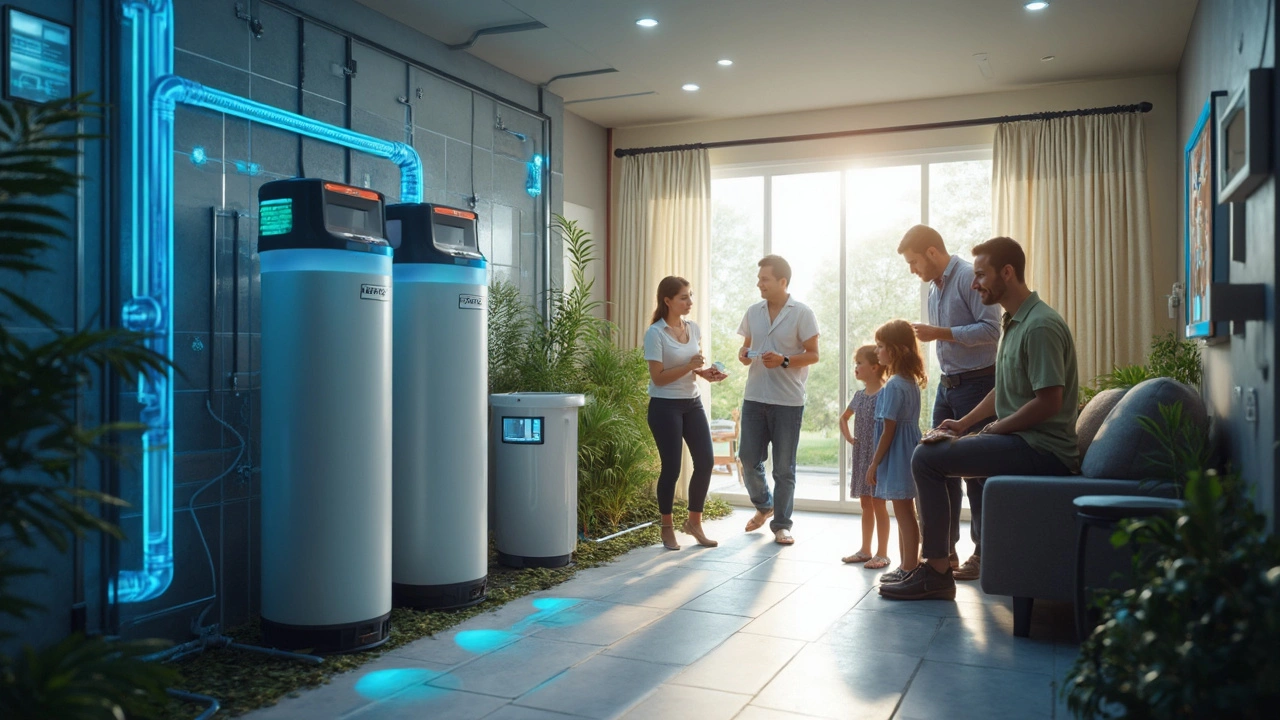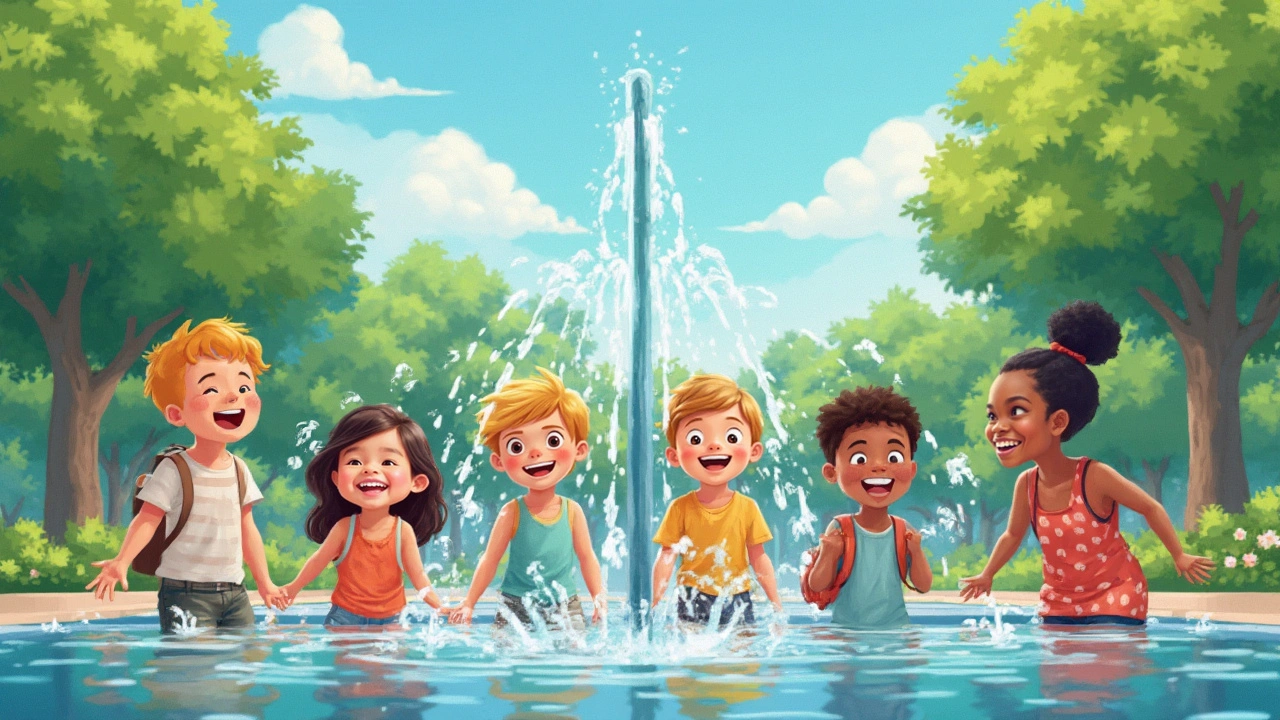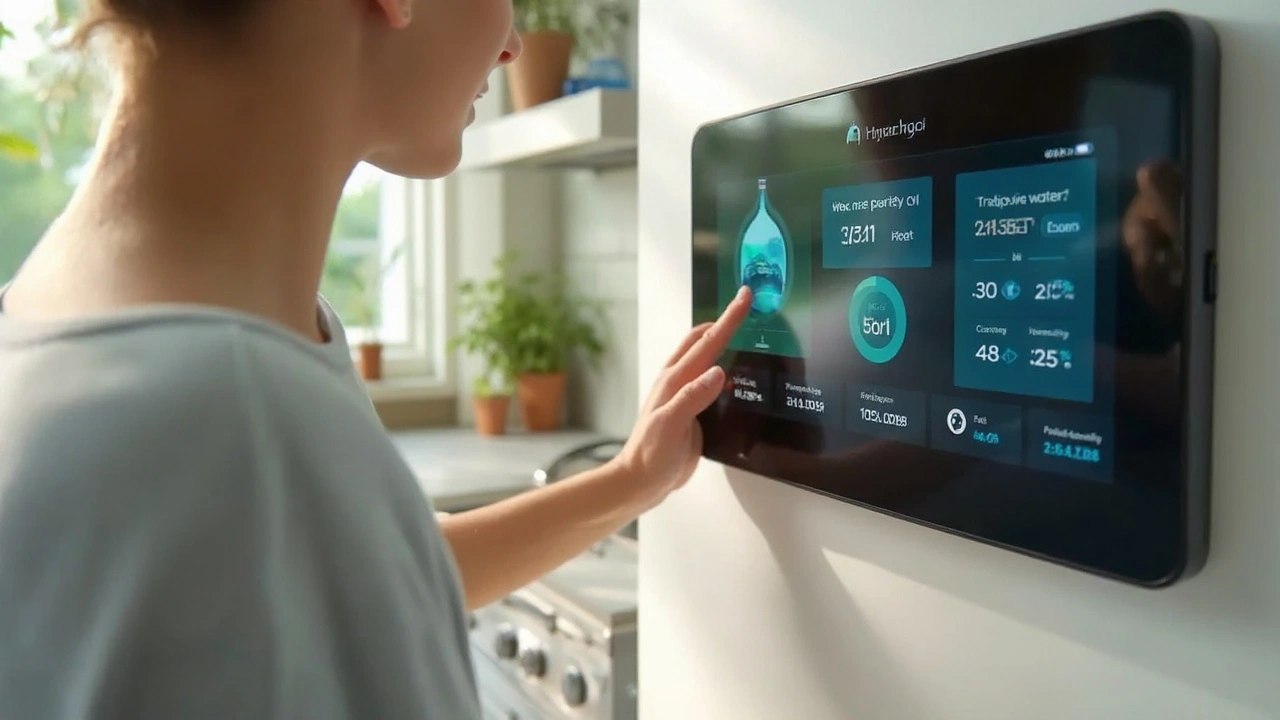Hydrocl: Revolutionizing Water Treatment with Smart Solutions
 Jun, 20 2025
Jun, 20 2025
Every time you pour yourself a glass of water, have you wondered what really happens before that crystal-clear liquid flows from your tap? Most people assume there’s a generic filter under the sink or maybe just trust their municipality to handle things. But the old ways just aren’t cutting it anymore. Water contamination is wild—think microplastics, emerging pharmaceuticals, traces of heavy metals, bacteria sneaking through aging pipes. The idea of 'clean water' isn’t as simple as it sounds. This is where Hydrocl crashes onto the scene, shaking up water treatment with innovative, data-driven technology. It’s smart, more efficient, and—here’s the kicker—puts you in the driver’s seat when it comes to knowing and controlling your water.
What is Hydrocl and How Does It Work?
Before Hydrocl arrived, most household water systems worked on a timer or a set schedule. Filters sat in place and just...strained whatever came through, with no regard for what’s actually in the water at that moment. Hydrocl flipped that script and introduced something you rarely see in home water purification: real-time monitoring. Their flagship devices are as small as a toaster, yet punch well above their weight. Inside, they pack an array of sensors that track over two dozen parameters—chlorine, pH, dissolved solids, temperature, nitrate levels, even traces of antibiotics. All this happens while water rushes past at your regular flow rate. The brains behind it? Machine learning algorithms that scan the sensor data and make instant decisions: does the filter need an upgrade, is a contaminant spike happening, is maintenance overdue?
Here’s the cool part—users don’t have to be engineers to understand any of this. Hydrocl’s interface beams the results right to your phone, laying out stats in actual human language. Imagine getting a ping at noon: "Chlorine just spiked, but we’re handling it. Your water is safe." Or maybe you’ll see a weekly summary: "There’s been an uptick in microplastics—filter replacement recommended." The system even maps historical trends, so you spot patterns, like surges after a big rainstorm or during construction nearby. There’s something strangely satisfying (and reassuring) about seeing your water quality compared to neighborhood norms or national standards.
How did Hydrocl nail this? The company ran trials from crowded Bangkok apartments to rural Idaho cabins. They worked with universities to calibrate sensors and tested algorithms on every type of gunk you can imagine. This research feeds back to the consumer; if a new pollutant becomes a concern, the software updates overnight. Even regulatory compliance gets easier. Some early customers, hospitals and schools especially, say audits just got simpler with Hydrocl’s downloadable water reports and alerts.
| Feature | Traditional Filter | Hydrocl |
|---|---|---|
| Testing Method | Manual/Lab | Real-time Sensors |
| Filter Change | Fixed intervals | Condition-based (needs-driven) |
| Contaminants Detected | Limited (5-7) | 20+ Types |
| User Reporting | None/Manual | Instant, Mobile, Cloud-based |
| Learning Updates | Never | Automatic, AI-driven |

The Technology Inside Hydrocl: Not Just Another Filter
Ask anyone who has tried to hack together a water filter system from hardware store parts—there’s a lot more to it than shoving some charcoal in a tube. Hydrocl’s tech takes it much further, combining multiple layers and techniques in one sleek device. First, there’s ultrafiltration for blocking bacteria and protozoa, then activated carbon to trap chemical nasties—like pesticides or industrial solvents. But the biggest advance? Their selective ion exchange resin, which can dial in on heavy metals (think lead, arsenic, copper) without scrubbing away useful minerals like calcium.
The magic doesn’t stop there. The true brains rest with those embedded micro-sensors, built using nanotechnology that makes them ultra-sensitive. We’re talking about the difference between catching one fish with a net versus knowing every single species swimming in a river as it passes. That’s how Hydrocl distinguishes between similar contaminants, flagging which ones are harmless and which need action. All this data zips to the cloud, where their AI chews through thousands of water profiles, tweaks the filter cycles, gives better recommendations, and even predicts when your filter might clog. Scary accurate. If you want, you can actually tap into these analytics as a user.
Let’s talk about maintenance, because we all hate surprise chores. Most filters just stop working and you don’t notice until something tastes off. Hydrocl tracks cumulative filter load so it prompts you with a gentle "Hey, swap me soon" alert on your phone weeks before performance dips. Got hard water or lots of family guests? The system recalibrates filter life expectations. And unlike those generic replacement cartridges, Hydrocl’s are coded to the unit, so you never deal with the wrong size or a shady knockoff. You’re paying for the good stuff every time.
Interested in water source variability? If your area switches water sourcing (surface to groundwater, say, due to drought), Hydrocl logs the changes and adapts its filtration logic. It’s like a barista who knows you always want oat milk when you have company, but regular for your morning coffee run. No two households have the same needs or contaminants, so this kind of learning is a real game changer.
Safety matters most here. Hydrocl’s sensors independently cross-check each other, so if the nitrate tracker acts weird, the TDS (total dissolved solids) probe backs up the data. Triple failsafes mean fewer false alarms and more confidence in alerts. Plus, if you’re a data nerd, you can export years of readings—handy for checking on changes after plumbing work, or if you want proof when filing a complaint to city services. This isn’t just peace of mind—it’s your health, your family’s safety, and zero guesswork.

Why Hydrocl Matters: Impact, Benefits, and Real-World Tips
Water issues are creeping up everywhere, even in places you wouldn’t expect. In 2023 alone, nearly 36% of U.S. counties faced some degree of boil-water advisories due to aging infrastructure or climate-driven flooding. Boiling removes bacteria, but not chemical runoff or metals. With Hydrocl’s real-time detection, you actually know what you’re drinking—something a boiling pot can’t promise. For city dwellers, sudden street works or construction can introduce bursts of sediment and nasties. Imagine having a dashboard that instantly tells you, "Something’s in the water, don’t use it right now." It’s power.
One early tip from Hydrocl power-users: track your usage trends. If you notice spikes in contaminants after storms, consider a pre-filter for heavy silt, or run a cleaning cycle before everyone pours their first glass. Heatwaves can drive chemical concentrations, so quick daily checks on the app help spot problems before you taste them. Don’t ignore those maintenance nudges—filters under heavy use wear out faster than you’d think.
Travelers and renters can benefit too. If you don’t own your place, a countertop Hydrocl model lets you take advanced filtration with you—plop it down, plug it in, and tap, you’re protected, no permanent installation needed. Off-grid folks and campers? Hydrocl’s portable units run off battery packs, so safe river or lake water is in reach, no matter where your adventure leads. Growing trend: rural families using Hydrocl to monitor well water, catching nitrate spikes before they become a health risk.
Schools and care homes now have more accountability because they can pull up detailed water logs for parents or regulatory inspections. Hospitals reduce patient risk from opportunistic pathogens in their plumbing, since the system instantly spots dangerous fluctuations. Some cities are even trialing Hydrocl in public fountains and community centers to monitor quality and spot tampering, as part of a move toward "smart city" water management.
| Year | U.S. Water Advisories (%) | Common Issues Detected |
|---|---|---|
| 2021 | 29 | Bacteria, lead, sediments |
| 2022 | 32 | Chlorine spikes, microplastics |
| 2023 | 36 | Nitrates, heavy metals |
| 2024 | 34 | Antibiotics, agriculture runoff |
If you’re thinking about making the switch, here’s what helps:
- Pick the Hydrocl model that fits your lifestyle. Countertop for flexibility, inline for whole-home peace of mind.
- Sync the app and personalize alerts. Set thresholds for sensitive users—think infants, pregnant women, seniors.
- Download your data monthly. If you notice changes, address them or share with your local water authority.
- Don’t skip filter changes. Even the best design works only when maintained right.
- Curious about neighborhood water? Compare your stats with public dashboards and see if spikes are personal or citywide.
People often forget small, daily moments—kids refilling bottles, grandparents making tea, a quick face wash after gardening. With Hydrocl in the background, every drop is a little more trustworthy. You get to relax, knowing technology’s quietly guarding your tap. You control your water, not the other way around. Safe, smart, and just a lot more human—you’ll wonder why we didn’t have this sooner.
ka modesto
June 30, 2025 AT 09:13Okay, I’ve been using Hydrocl for six months now and I’m honestly blown away. My kids used to complain about the taste of tap water-now they ask for refills. The app shows me exactly what’s in there, and I’ve caught two spikes in nitrates after heavy rains that my old filter would’ve totally missed. The AI updates are wild too-last week it flagged a new contaminant from agricultural runoff that wasn’t even on the radar last month. No more guessing. Just pure peace of mind.
Also, the filter replacement alerts? Perfect. I used to just swap them every six months like a robot. Now I know exactly when it’s needed. Saved me a couple hundred bucks last year on unnecessary replacements.
Holly Lowe
July 2, 2025 AT 06:12THIS IS THE FUTURE, Y’ALL. 🤯 Imagine your water having a personality-and it’s the chill, nerdy bestie who texts you when something’s off. Hydrocl doesn’t just filter water, it *understands* it. I got a notification last Tuesday that said, ‘Hey, your water’s tasting a little metallic today-probably copper leaching from your pipes.’ I called a plumber, turns out it was my 1978 water heater. Saved me from a full-blown plumbing disaster. Also, I now have a spreadsheet of my water quality trends. I’m weirdly proud of it.
Also, the emoji in the app? Chef’s kiss. 🍃💧
dayana rincon
July 3, 2025 AT 14:37So… you pay $800 to get a fancy water filter that texts you when your tap water is… water? 🤨
My $20 Brita does the same thing, but without the algorithmic drama.
Cindy Burgess
July 5, 2025 AT 13:49While the technological sophistication of Hydrocl is undeniably impressive, one must consider the economic and environmental implications of deploying such a high-end, proprietary system at the consumer level. The embodied energy in the sensor array, the lithium-ion dependency for cloud connectivity, and the proprietary filter cartridges create a non-trivial lifecycle burden. Moreover, the psychological reinforcement of consumer dependency on algorithmic validation for a basic human need-potable water-raises epistemological questions regarding autonomy and trust in infrastructure.
Perhaps a more sustainable path lies in municipal investment in infrastructure modernization, rather than individualized technological band-aids.
Tressie Mitchell
July 7, 2025 AT 04:26Oh wow. A $799 gadget that tells you your water is safe? How quaint. I suppose the rest of us are just peasants drinking from the same rusty pipes our ancestors did. Meanwhile, real innovators are building AI-powered desalination plants in the Middle East. This feels like a Silicon Valley vanity project dressed up as public health. If your water needs a smartphone app to tell you it’s not poison, maybe you live in the wrong country.
Also, I’m pretty sure my local utility has better data than this thing ever will.
Sondra Johnson
July 7, 2025 AT 05:10I get where Cindy’s coming from-municipal investment is critical. But let’s not pretend everyone lives in a city with a $2 billion water budget. My cousin in rural Kentucky uses a well that’s been contaminated by runoff from a nearby hog farm. Hydrocl gave her the data to finally get the county to test it properly. She’s not buying this for the ‘aesthetic’-she’s buying it because her toddler’s bloodwork showed elevated lead levels. Sometimes, the band-aid *is* the lifeline.
And honestly? If this tech pushes cities to upgrade because they see how much people care… that’s a win. Let’s not throw the baby out with the bathwater. (Pun intended.)
Chelsey Gonzales
July 8, 2025 AT 21:07ok so i got the countertop one and it’s kinda magic?? like i thought i was just buying a filter but now i’m obsessed with checking my water score every morning 😅 the app even tells me when my water’s better than my neighbor’s?? weird flex but ok.
also i spilled coffee on it once and it still worked. that’s a win in my book. no more buying plastic bottles. my wallet and the planet are thanking me. 🌎💚
MaKayla Ryan
July 10, 2025 AT 13:02Let me get this straight-Americans are paying $800 to monitor their tap water because they can’t trust their own government? What happened to just boiling it? This is why we’re losing our edge. In China, they have national water grids that monitor everything from space. Here? We’re out here buying apps to tell us our water isn’t turning us into toxic waste. Pathetic.
Also, why are we letting tech companies profit off basic human needs? This is capitalism gone rogue.
Simran Mishra
July 11, 2025 AT 17:00I’m from India, where water contamination is a daily reality-not a trending topic on Reddit. We don’t have the luxury of choosing between a $20 filter and a $800 one. We have what we have. But I watched a documentary last year about a village in Rajasthan where a nonprofit installed something like Hydrocl-low-cost, solar-powered, community-shared sensors-and it changed everything. Kids stopped getting sick. Schools started serving tap water. The government took notice.
So yes, this tech is expensive. Yes, it’s marketed like a luxury. But the underlying idea? That water quality should be known, not assumed-that’s universal. I don’t need the app. I need the principle. And if this company can make it scalable, affordable, open-source… then they’re not just selling filters. They’re selling dignity.
Maybe we don’t all need our own device. Maybe we just need the data to be free.
Orion Rentals
July 13, 2025 AT 15:45As a public health engineer with over two decades of experience in municipal water systems, I find the Hydrocl platform to be a compelling augmentation to existing infrastructure. While it does not supplant the necessity for centralized treatment and regulatory oversight, its real-time, granular feedback mechanism offers a novel form of distributed sensing that can serve as an early-warning network. The integration of machine learning for contaminant pattern recognition aligns with emerging paradigms in environmental informatics.
I would encourage the developers to pursue interoperability with EPA’s Safe Drinking Water Information System (SDWIS) to facilitate data sharing with public agencies. Such collaboration could transform consumer-grade devices into validated components of a national water quality monitoring architecture.